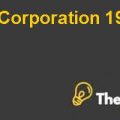
AMERICAN CANCER SOCIETY: ACCESS TO CARE Case Solution
Question 1: Organizational Structure
How has the organizational structure for ACS changed to support the Access to Care Strategy? Explain in detail.
The structure of an organization is dependent on its strategy as stated by the contingency theory. There has been a huge shift in the makeup of the board of the company not because of the Access to Care strategy but to get the right board leadership. This structural change had been implemented in the year 2008. A National Home Office had been created which was based on Atlanta, Georgia and there were 13 separate regional divisions, all of which were independently accountable.
Each of these 13 divisions consisted of the multiple local offices and division headquarters. There were now around 43 total members in the board. The National CEO, John Seffrin, is the only one who is accountable to the board and answers them. All the limitations and the measurable goals for the CEO are set by the board. The National Assembly had elected the national board of directors and it comprised of around six volunteer delegates. A charter was signed between all the 13 divisions, every three years. This ensured that the agreements and the expectations of the National Home Office and the Board were same.
The progress for the agreed upon goals of each of the 13 divisions was measured by a representative of National Home Office. The same auditor, which is Ernst & Young, audits all the 13 divisions. It is evident that ACS follows a functional organizational structure and the decision making process is centralized. This is evident from Figure A in the case. The board had also formed a volunteer structure and the staff structure for developing, communicating and executing new policies in each of the division to support the initiative.
This is a perfect structure for supporting the Access to Care Strategy because all the divisional heads are working separately but similarly to achieve a common goal. They also meet regularly through the chartering process to measure their progress. All the divisions are provided with the incentives to collaborate. Finally, the 2015 goals provided a single roadmap to follow each of the divisions so that they could achieve shared outcomes.
Question 2: Strategic Investment Decisions
How are the strategic decisions made by the board at ACS and what you think about Access to Care Strategic Decision of ACS?
The strategic decisions at ACS are made through detailed discussions, meetings and collaboration of the executive team and the. The board and the CEO had collaboratively formed the Access program. The lack of access had been identified as a major cancer killer and it was growing. The Access program had been developed to address this issue.However, each of the 13 division also had their own CEOs and their independent boards. They do not have to follow John but,it is the communication process at ACS through which the major strategic decisions are made and discussed among all the divisions. This is possible only because of the strong commitment and support of all the volunteers for the cancer cause. One example of this commitment is the formulation of the 2015 Goals, which were highly valuable in aligning all the 13 regional divisions.
If we talk about the Access to Care initiative, then this initiative fits strategically with the mission of ACS. Previously, the organization was committed towards the prevention, detection and research for cancer patients however, under the leadership of John Seffrin, it had been realized by everyone at ACS that the biggest hurdle for the cancer patients was due to lack of access to care and this was the gap which ACS wanted to pursue.....................
This is just a sample partial case solution. Please place the order on the website to order your own originally done case solution.












